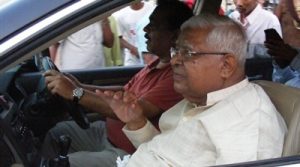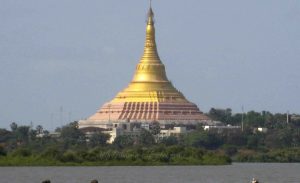(30 January 1924 – 29 September 2013)
Atta Hi Attanano Natho, Atta Hi Attano Gati.
One Is One’s Own Master, And Works Out One’s Salvation With One’s Own Efforts.

Padma Bhushan Global Vipassana Acharya Satya Narayan Goenka, has passed away peacefully at the ripe age of 90 on Sunday, 29th September, 2013. The funeral was held on 1st October, 2013 at Mumbai, India.
Mr. Satya Narayan Goenka’s contribution to spread of Buddhism via Vipassana in India is immensely high and with his demise the Spread of Buddhism movement in India has come to a crossroad. Vipassana, a form of meditation that can be traced back to the Buddha was introduced to Indians by Mr. Goenka. He was popularly known as Goenka Guruji amongst the Vipassi Sadak.

A former industrialist, born and raised in a staunch, conservative Hindu family in Burma (i.e. Myanmar). While searching for a ‘cure’ for his migraines came across Vipassana. He met Mr. Sayagyi U Ba Khin (1899-1971) who taught him meditation. After he was cured from migraines, he decided to master the science and art of Vipassana under the guidance of his teacher, Mr. Khin and he went on studying Vipassana for 14 years. After handing over his business to family, Goenka Guruji decided to spent the rest of his life learning and teaching the meditation. In 1969, Goenka Guruji came to India and re-introduced Vipassana (as the Buddha’s teaching was lost over the years in India) and set-up the first meditation centre at Dhamma Giri, Igatpuri, India. The gates of the Vipassana International Academy were opened to the public in 1976. Goenka Guruji conducted the first ten-day course at Dhamma Giri from 27 October to 7 November 1976. The opening of Dhamma Giri marked an important step in the spread of Dhamma. Since 1969, Goenkaji had conducted courses in temples, churches, mosques, pilgrims’ rest houses, monasteries, schools, and hotels. These “gypsy camps” (non-centre camps) were invaluable in the spread of Dhamma, but obviously it would be still more valuable to have a place specifically for the practice of Vipassana meditation. The importance of establishing a centre was stressed by Mr. Sayagyi U Ba Khin, in the early seventies; he was visited by the first of Goenkaji’s students in Myanmar. There were, however, many obstacles, not all of them financial. One was that while the Buddha is held in high respect in India, his teaching is widely regarded with suspicion. If a centre was founded to spread the teaching of the Buddha, it might be regarded as a sectarian institution, in which case its appeal would be limited only to a small group of people. Aware of this danger, Goenkaji emphasized strongly the non-sectarian, universal nature of Vipassana meditation. He made it clear that Dhamma Giri was not to be the property of any group, but was for the benefit of all who sought a way out of suffering. His also followed his teacher Sayagyi’s philosophy that there should not be admission or subscription fee or fixed donation payable by the disciples. All 173 meditation centers world over (60 centers in India) accepts aid and donation only from disciples who have undergone the Ten days Course themselves with Vipassana meditation Centers and there is no compulsion for donation. Goenka Guruji was confident that the Dhamma would overcome these obstacles. He worked tirelessly to realize his Teacher’s goal of establishing a centre from which the Dhamma could spread not only in India but around the world. The website for registering for Ten Days Vipassana course is http://www.vridhamma.org.
Goenka Guruji had received the Padam Bhushan in 2012 for his contribution to the society from the Government of India.

Global Pagoda at Mumbai (http://www.globalpagoda.org)
In order to make a long lasting place for Vipassana in Mumbai Goenka Guruji built a Global Pagoda at Gorai, Mumbai, India. Planning for the construction of the Global Vipassana Pagoda began in 1997, while actual building work started in 2000. The pagoda consists of three sub-domes. The first and largest dome was completed when bone relics of Buddha were enshrined in the central locking stone of the dome on October 29, 2006, making it the world’s largest hollow stone masonry structure containing relics of the Buddha. The relics were originally found in Bhattiprolu, Guntur district, Andhra Pradesh, South India. They have been donated by the Mahabodhi Society of India and the Prime Minister of Sri Lanka to be kept at the Global Vipassana Pagoda. The second and third domes, along with an auxiliary dome adjoining the second dome, sit atop the first dome. Construction of the third dome was structurally completed on November 21, 2008.

The center of the Global Vipassana Pagoda contains the world’s largest stone dome built without any supporting pillars. The height of the dome is approximately 29 meters, while the height of the building is 96.12 meters, which is twice the size of the previously largest hollow stone monument in the world, the Gol Gumbaz Dome in Bijapur, India. The external diameter of the largest section of the dome is 97.46m and the shorter sections, is 94.82m. The internal diameter of the dome is 85.15m. The inside of the pagoda is hollow and serves as a very large meditation hall with an area covering more than 6000 sq m (65,000 sq ft). The massive inner dome seats over 8000 people, enabling them to practice the non-sectarian Vipassana meditation as taught by Goenka Guruji and now being practiced in over 173 centers in more than 60 countries. An inaugural one-day meditation course was held at the pagoda on December 21, 2008, with Mr. Satya Narayan Goenka in attendance as the teacher.
The aim of the pagoda complex is to express gratitude to Buddha for dispensing a universal teaching for the eradication of suffering, to reveal the truth about the life of Buddha and His teaching, and to provide a place for the practice of Vipassana meditation. Vipassana meditation courses are held free of charge at the meditation centre that is situated in the Global Vipassana Pagoda complex.
The Global Vipassana Pagoda constructed under the guidance of Goenka Guruji is declared as one of the “Seven Wonders of Maharashtra” by Maharashtra Tourism Development Corporation (MTDC).

Some of the important Dhamma Talk by Goenka Guruji can be viewed at the following link:-
- http://www.youtube.com/watch?v=x19lE-8tpQw ( in Hindi)
- https://www.youtube.com/watch?v=albRE0Gme94 (Dhamma Land Myanmar Tour with S. N. Goenka in JAN 2000- English)
- https://www.youtube.com/watch?v=s3wiVLYl_UU ( Vipassana S. N. Goenka speech at Harvard Business Club 1 – English)
- https://www.youtube.com/watch?v=pfpYdOC9xEo ( Vipassana S. N. Goenka speech (Q&A) at Harvard Business Club 2 – English)
https://www.youtube.com/watch?v=MBQnrmjaslY ( Vipassana Teacher’s Self Course- S. N. Goenka – English and Hindi )
Published in Issue IV, October 2013
